Table of Contents
Simple Equations Class 7 Extra Questions Maths Chapter 4
Extra Questions for Class 7 Maths Chapter 4 Simple Equations
Simple Equations Class 7 Extra Questions Very Short Answer Type
Question 1.
Write the following statements in the form of equations.
(a) The sum of four times a number and 5 gives a number five times of it.
(b) One-fourth of a number is 2 more than 5.
Solution:
(a) Let the number be x.
Sum of 4x and 5 = 4x + 5
The sum is 5x.
The equation is 4x + 5 = 5x as required.
(b) Let the number be x.
\(\frac { 1 }{ 4 }\)x = 5 + 2
⇒ \(\frac { 1 }{ 4 }\)x = 7 as required.
Question 2.
Convert the following equations in statement form:
(a) 5x = 20
(b) 3y + 7 = 1
Solution:
(a) Five times a number x gives 20.
(b) Add 7 to three times a number y gives 1.
Question 3.
If k + 7 = 10, find the value of 9k – 50.
Solution:
k + 7 = 10
⇒ k = 10 – 7 = 3
Put k = 3 in 9k – 50, we get
9 × 3 – 50 = 27 – 50 = -23
Thus the value of k = -23
Question 4.
Solve the following equations and check the answers.
![]()
Solution:
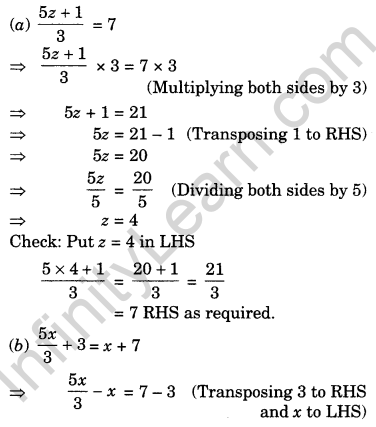
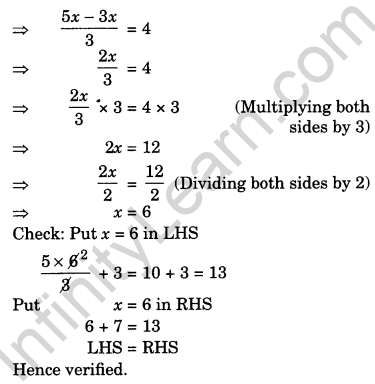
Question 5.
Solve the following equations:
3(y – 2) = 2(y – 1) – 3
Solution:
3(y – 2) = 2(y – 1) – 3
⇒ 3y – 6 = 2y – 2 – 3 (Removing the brackets)
⇒ 3y – 6 = 2y – 5
⇒ 3y – 2y = 6 – 5 (Transposing 6 to RHS and 2y to LHS)
⇒ y = 1
Thus y = 1
Question 6.
If 5 is added to twice a number, the result is 29. Find the number.
Solution:
Let the required number be x.
Step I: 2x + 5
Step II: 2x + 5 = 29
Solving the equation, we get
2x + 5 = 29
⇒ 2x = 29 – 5 (Transposing 5 to RHS)
⇒ 2x = 24
⇒ x = 12 (Dividing both sides by 2)
⇒ x = 12
Thus the required number is 12.
Question 7.
If one-third of a number exceeds its one-fourth by 1, find the number.
Solution:
Let the required number be x.
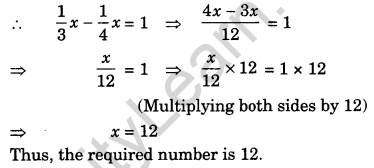
Simple Equations Class 7 Extra Questions Short Answer Type
Question 8.
The length of a rectangle is twice its breadth. If its perimeter is 60 cm, find the length and the breadth of the rectangle.
Solution:
Let the breadth of the rectangle be x cm.
its length = 2x
Perimeter = 2 (length + breadth) = 2(2x + x) = 2 × 3x = 6x
As per the condition of the question, we have
6x = 60 ⇒ x = 10
Thus the required breadth = 10 cm
and the length = 10 × 2 = 20 cm.
Question 9.
Seven times a number is 12 less than thirteen times the same number. Find the number.
Solution:
Let the required number be x.
7x = 13x – 12
⇒ 7x – 13x = -12 (Transposing 13x to LHS)
⇒ -6x = -12
⇒ x = 2
Thus, the required number is 2.
Question 10.
The present age of a son is half the present age of his father. Ten years ago, the father was thrice as old as his son. What are their present age?
Solution:
Let the present age of a father be x years.
Son’s age = \(\frac { 1 }{ 2 }\)x years
10 years ago, father’s age was (x – 10) years
10 years ago, son’s age was (\(\frac { x }{ 2 }\) – 10) years
As per the question, we have
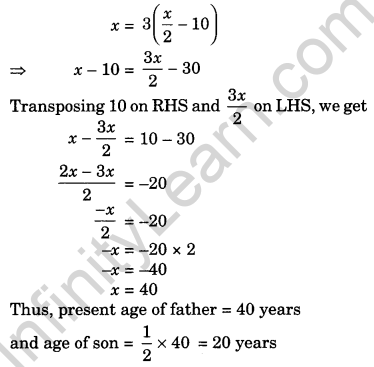
Question 11.
The sum of three consecutive multiples of 2 is 18. Find the numbers.
Solution:
Let the three consecutive multiples of 2 be 2x, 2x + 2 and 2x + 4.
As per the conditions of the question, we have
2x + (2x + 2) + (2x + 4) = 18
⇒ 2x + 2x + 2 + 2x + 4 = 18
⇒ 6x + 6 = 18
⇒ 6x = 18 – 6 (Transposing 6 to RHS)
⇒ 6x = 12
⇒ x = 2
Thus, the required multiples are
2 × 2 = 4, 4 + 2 = 6, 6 + 2 = 8 i.e., 4, 6 and 8.
Question 12.
Each of the 2 equal sides of an isosceles triangle is twice as large as the third side. If the perimeter of the triangle is 30 cm, find the length of each side of the triangle. [NCERT Exemplar]
Solution:
Let the length of the third side be x cm.
Each equal side = 2x cm.
As per the condition of the question, we have
Perimeter = x + 2x + 2x = 30
⇒ 5x = 30
⇒ x = 6
Thus, the third side of the triangle = 6 cm
and other two equal sides are 2 × 6 = 12 cm each
Question 13.
A man travelled two-fifth of his journey by train, one-third by bus, one-fourth by car and the remaining 3 km on foot. What is the length of his total journey? [NCERT Exemplar]
Solution:
Let the total length of total journey be x km.
Distance travelled by train = \(\frac { 2 }{ 5 }\)x km
Distance travelled by bus = \(\frac { 1 }{ 3 }\)x km
Distance travelled by car = \(\frac { 1 }{ 4 }\)x km
Remaining distance = 3 km
As per the question, we have
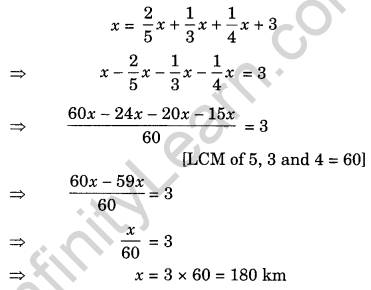
Thus, the required journey = 180 km.






